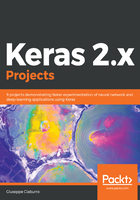
Learning paradigms
Learning consists of acquiring or changing knowledge, behaviors, abilities, and preferences. Human beings, animals, and plants possess this ability. The purpose of algorithms based on neural networks is to extend this feature to machines. Learning can be done by following different models depending on the feedback provided to the system. There are essentially two types of learning for neural networks, namely supervised and unsupervised.
By analogy, with human beings, we can learn from observations without any kind of target model (without supervision), or we can have a teacher who shows us the right model to follow (supervised). Halfway between supervised and unsupervised learning, there's semi-supervised learning, in which the teacher provides an incomplete dataset for training - that is, a set of training data among which there is data without the respective desired output. In Chapter 3, Heart Disease Classification with Neural Networks, we already introduced the topic. Let's go into the details of these concepts.